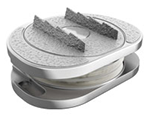The Lumbosacral Joint – L5-S1
Anatomy
L5 vertebra consists of a vertebral body in the front and an arch in the back that has 3 bony protrusions: one prominent spinous process in the middle and two transverse processes on either side.
L5 vertebra
L5-51 intervertebral disc
S1 vertebra
L5-S1 intervertebral disc provides cushioning and shock-absorbing functions to protect L5 and S1
vertebrae during spinal movements.
L5 spinal nerve roots join with other nerves to form bigger nerves that extend down the spine and travel down each leg.
S1 vertebra, also called the sacral base, is the wide upper end of the triangle-shaped sacrum.
Common Problems
Disc problems. A steeper inclination of the L5-51 disc leads to a higher degree of shear stresses and increases the risk disc of injury and degeneration.
Facet joint pain. The lumbosacral joint may develop wear-and-tear arthritis (osteoarthritis) over time due to its high load-bearing function.
Spondylolysis. The L5 vertebra is susceptible to spondylolysis, which is a fracture of the pars interarticularis most commonly due to repetitive stress on the bone.
Spondylolisthesis. If the pars of L5 fractures on both sides, the vertebra may slip over S1 in a condition called spondylolisthesis.
Common Symptoms and Signs
Pain, felt as a sharp, shooting, and/or searing feeling in the buttock, thigh, leg, foot, and/or toes Numbness in the foot and/or toes
Weakness in the leg and/or foot muscles and an inability to lift the foot off the
